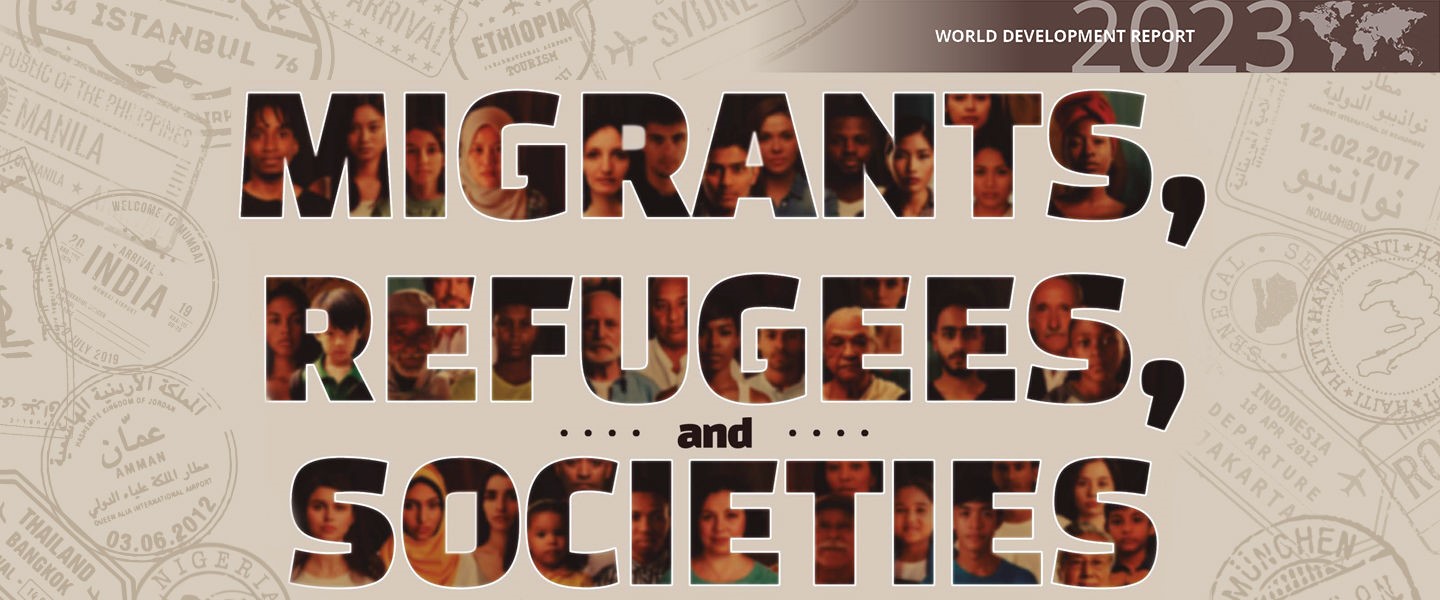
Disclaimer: Copyright infringement not intended.
Context
- Recently, the World Development Report 2023: Migrants, Refugees, and Societies was released by the World Bank.
Backdrop
- Migration is a development challenge. About 184 million people—3 percent of the world’s population—live outside of their country of nationality. Almost half of them are in low- and middle-income countries.
- As the world struggles to cope with global economic imbalances, diverging demographic trends, and climate change, migration will become a necessity in the decades to come for countries at all levels of income.
- If managed well, migration can be a force for prosperity and can help achieve the United Nations’ Sustainable Development Goals.
World Development Report 2023
- World Development Report 2023proposes an integrated framework to maximize the development impacts of cross-border movements on both destination and origin countries and on migrants and refugees themselves.
- The framework it offers, drawn from labor economics and international law, rests on a “match and motive” matrix that focuses on two factors:
-
- How closely migrants’ skills and attributes match the needs of destination countries and
- What motives underlie their movements.
- This approach enables policymakers to distinguish between different types of movements and to design migration policies for each. International cooperation will be critical to the effective management of migration.

Main Messages
Focus on people who live outside their country of nationality.
- The main difference between a migrant and a non-migrant is citizenship (or lack thereof) of the destination country and its associated rights.
- Once a migrant is naturalized, they no longer are a migrant: they face the same challenges and opportunities as other citizens—albeit in some cases with the added difficulties encountered by national minorities.
Recognize the complexity and the increasing necessity of cross-border movements.
- About 3 percent of the world’s population—184 million people, including 37 million refugees—live outside their country of nationality.
- Some 43 percent live in low- and middle-income countries.
- Many countries, at all income levels, are both the origin and destination of migrants at the same time.
- Because of demographic divergences and climate change, migration will become increasingly necessary over the next decades for countries at all income levels.
Distinguish between various types of movements to identify appropriate policy responses.
- How well migrants’ skills and attributes match the needs of destination countries largely determines the economic effects of their movements. The motives underlying movements determine destination countries’ obligations under international law.
- Maximize net gains when people bring skills and attributes that strongly match the needs of their destination society—for them, their countries of destination, and their countries of origin.
- Provide international protection to refugees in a manner that can be sustained, financially and socially—because most refugee situations last many years.
- Reduce the need for distressed movements, while respecting migrants’ human rights and dignity—and recognize development’s key role in this effort.
Manage migration strategically— In both origin and destination countries.
- Governments in origin countries should make labor migration an explicit part of their development strategy, while governments in destination countries should use “strong match” migration to meet their labor needs.
Manage cross-border movements differently.
- Use bilateral cooperation to strengthen the match of migrants’ skills and attributes with the needs of destination economies.
- Organize regional and global responses to address refugee movements and reduce the need for distressed movements. Develop new and predictable financing instruments.
- And listen to voices that are currently underrepresented in many policy debates.
CHAPTER SUMMARIES IN THE REPORT
The Match and Motive Matrix
- The Match and Motive Matrix, draws from labor economics and international law to identify priority policies for four types of movements based on who moves and under what circumstances.
- Where a migrant fits in the Match and Motive Matrix depends in part on their human capital and personal characteristics and, in part, on the policies of the destination countries.
- Over time, the challenge is to enhance migration outcomes by strengthening the match of all migrants’ skills and attributes with their destinations.
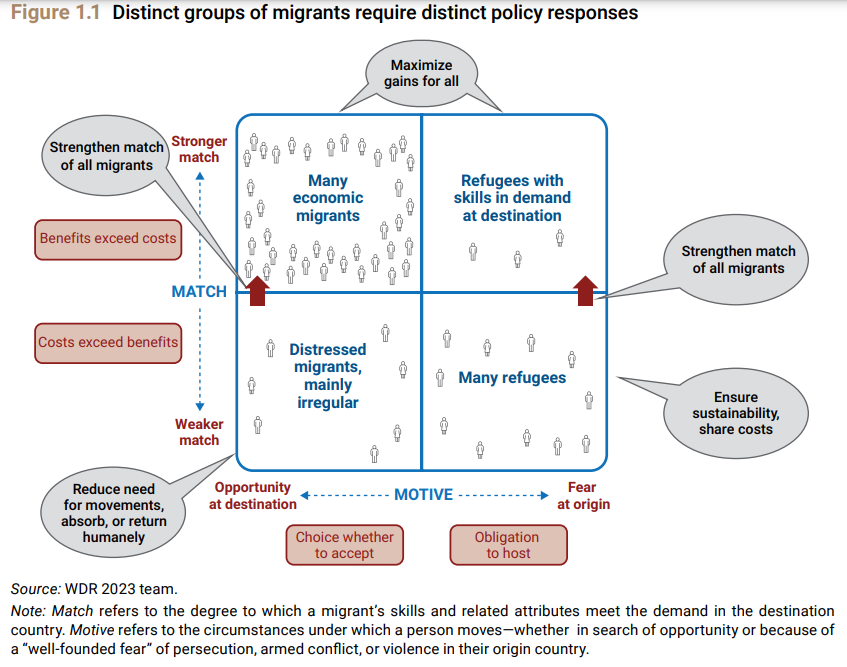
The numbers: Understanding who moves, where to, and why
- Migration is a response to global imbalances, such as large welfare differences, and to shocks such as conflict and violence.
- Some 184 million people live outside of their country of nationality, about 20 percent of whom are refugees.
- Patterns of movement differ based on migrants’ motives.
- Migrants and refugees live in countries in all income groups—43 percent in low- and middle-income countries; 40 percent in high-income member countries of the Organisation for Economic Co-operation and Development (OECD); and 17 percent in member countries of the Gulf Cooperation Council (GCC).
- There is no simple dichotomy between migrants’ countries of origin and countries of destination. Many countries at all levels of income are both, at the same time.
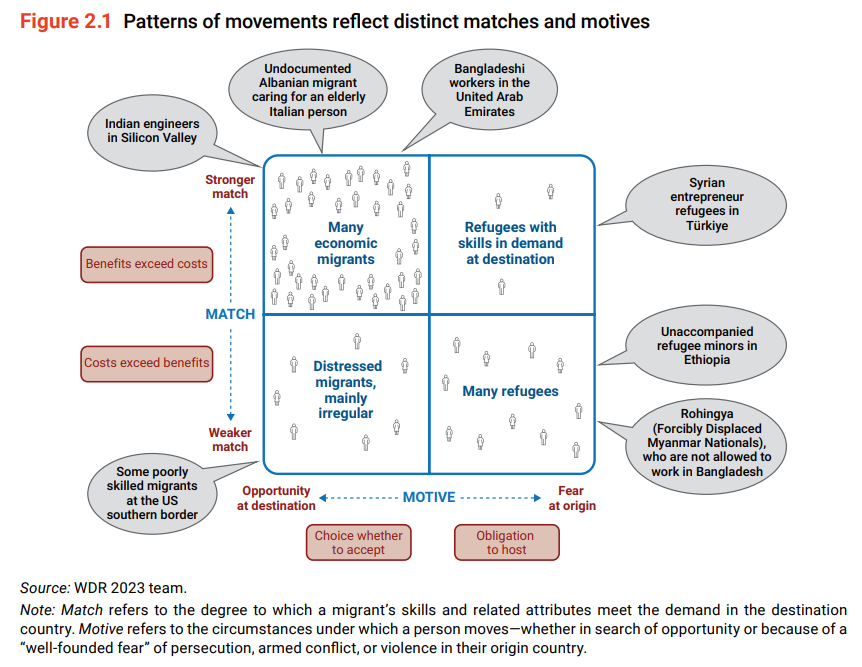
The outlook: Changing patterns, needs, and risks
- Two unprecedented forces—rapid demographic transitions and climate change—Cross-Border Movements are becoming both inevitable and necessary for migrants and economies at all levels of income. They will influence where many migrants stand in the Match and Motive Matrix.
- The populations of high-income and many middle-income countries are aging quickly, while the populations of low-income countries are expected to continue to grow. This trend is creating large mismatches between labor supply and demand across the world.
- Whether countries allow migration to help reduce some of these mismatches will largely determine economic and social trajectories at all income levels.
- Climate change is compounding other drivers of mobility. So far, most movements induced by climate impacts have been within countries.
- But climate change has the potential to increase distressed cross-border movements, and the global community urgently needs to limit global warming and support country-level adaptation policies.
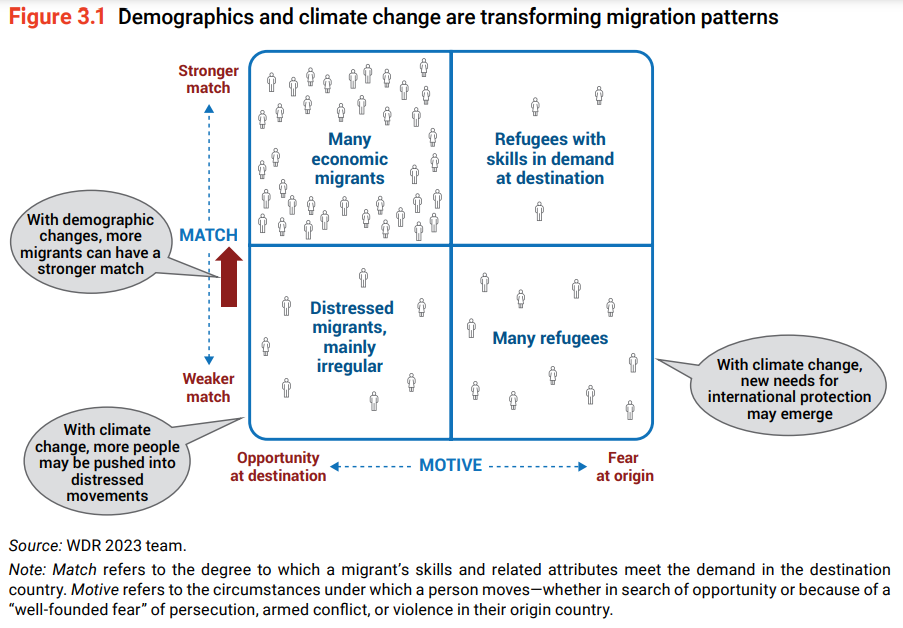
Origin countries: Managing migration for development
- When migrants’ skills and attributes are a strong match with the needs of destination countries, origin countries benefit as well. Benefits include remittances, knowledge transfers, and positive impacts on the labor market.
- These benefits accrue to both regular and irregular migrants, although migrants’ gains, and how much they can share with their families in their origin countries, are larger when they have regular status.
- However, the absence of migrants also has a downside for their families and origin countries, including the impacts of the brain drain when high-skilled workers emigrate.
- Although the costs tend to be smaller in magnitude than the gains, they are significant in some countries.
- Origin countries benefit most when they make labor emigration an integral part of their development strategy.
- In doing so, they can adopt policies and engage in bilateral cooperation with destination countries to increase the net impact of migration on poverty reduction.
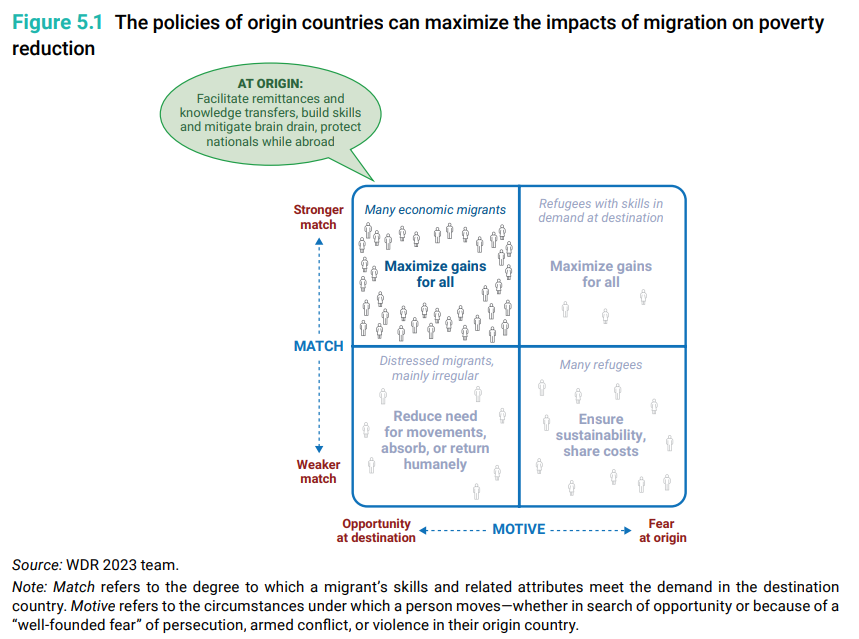
Destination countries: Maximizing gains through economic and social policies
- Destination countries gain significantly from the contributions of migrants whose skills and attributes strongly match their needs—even more so if migrants are allowed and able to work formally at the level of their qualifications.
- But there are costs too—for the use of public services, support for nationals who are negatively affected, and social integration.
- Destination countries can adopt policies that increase their gains, by facilitating economic and social inclusion.
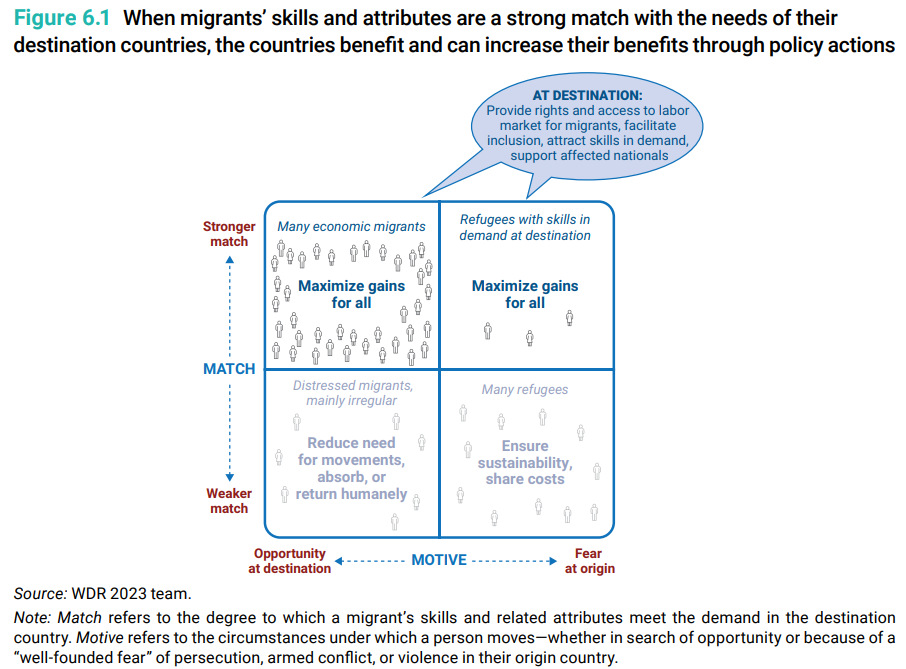
Refugees: Managing with a medium-term perspective
- Because refugees move for safety, they are not always able to reach destinations where their skills are in demand.
- This entails costs for the host country. Refugee situations tend to last for years, and they should be managed in a manner that can be sustained over time—both financially and socially.
- Host countries can reduce their cost through policies that foster internal mobility, self-reliance, and inclusion in national services.
- International responsibility-sharing is key to managing these costs, and it requires complementing global efforts with regional action.
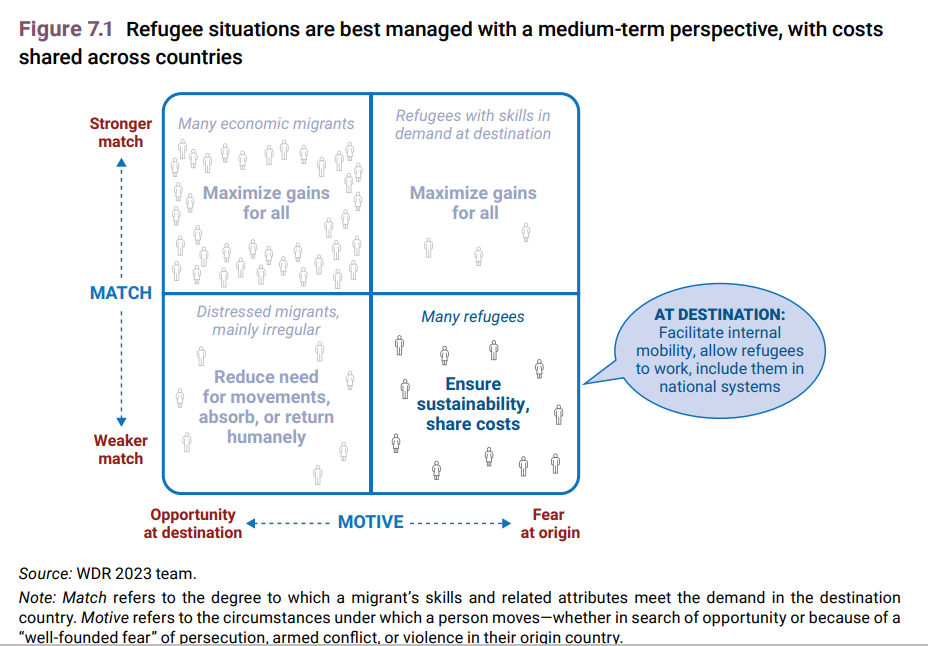
Distressed migrants: Preserving dignity
- Some migrants move without skills that match the needs in the destination country--and they are not refugees either.
- Such movements are often distressed—irregular and taking place under harrowing circumstances.
- Destination countries have the prerogative to accept or not such distressed migrants, but implementing restrictive policies without undermining migrants’ dignity has proved difficult.
- The challenge is to reduce the need for such movements, and development plays a critical role in this regard.
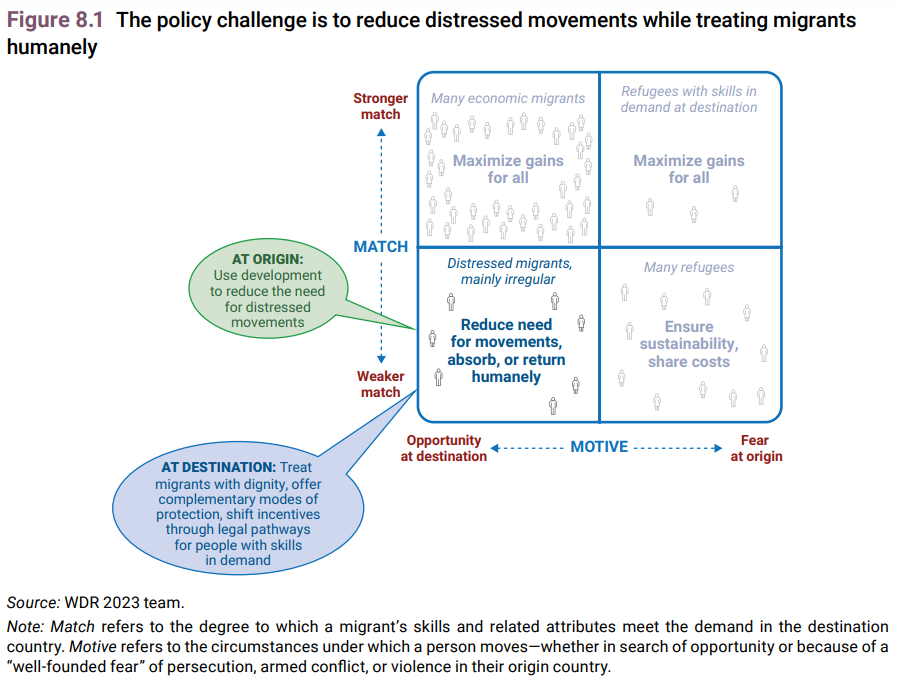
Recommendations: Making migration work better
- Making migration better will require countries to adopt policies that enhance the development effects of migration on their societies.
- The benefits of cross-border movements can also be increased (and the costs mitigated) through international cooperation.
- Bilateral and multilateral approaches are needed, as are better data, fit-for-purpose financing instruments, and bringing underrepresented voices to the debate.
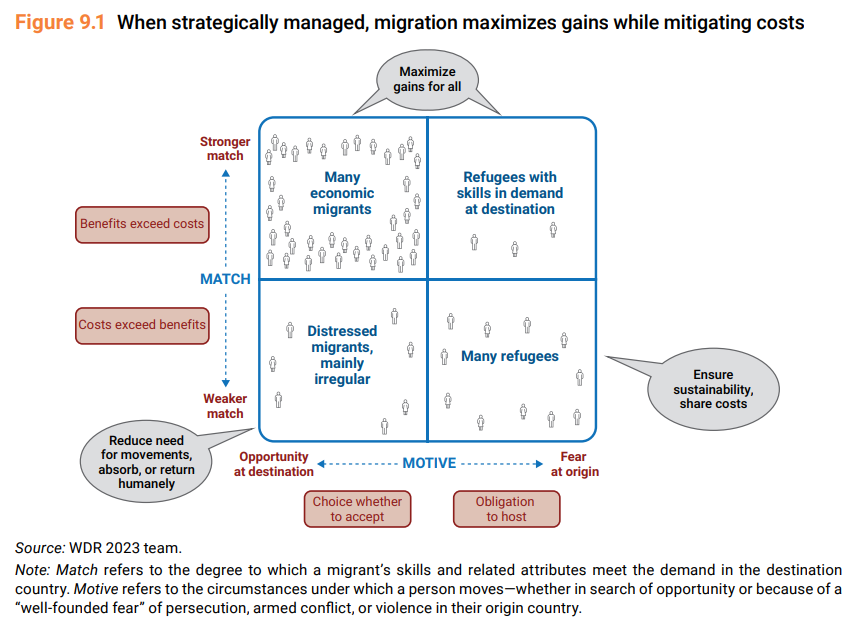
Closing Remarks
- Migration issues are becoming even more widespread and urgent due to severe divergences between and within countries— in terms of real wages, labour market opportunities, demographic patterns and climate costs.
- The World Bank urged for international cooperation and multilateral efforts to strengthen the match of migrants’ skills with the needs of destination societies.
- The report used data-driven and evidence-based examples and assessment of trade-offs, showing how migration can work for development.
- These policies can help harness economic opportunities and mitigate the difficulties and risks that migrants face.
|
PRACTICE QUESTION
Q. Migration issues are becoming even more widespread and urgent due to severe divergences between and within countries— in terms of real wages, labor market opportunities, demographic patterns, and climate costs. There is an urgent need for international cooperation and multilateral efforts to strengthen the match of migrants’ skills with the needs of destination societies. Examine.
|

https://www.worldbank.org/en/publication/wdr2023#:~:text=Reduce%20the%20need%20for%20distressed,key%20role%20in%20this%20effort.












